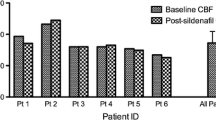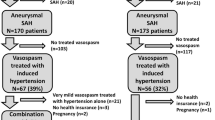Abstract
Background
Statins may promote vasodilation following subarachnoid hemorrhage (SAH) and improve the response to blood pressure elevation. We sought to determine whether simvastatin increases cerebral blood flow (CBF) and alters the response to induced hypertension after SAH.
Methods
Statin-naïve patients admitted <72 h after WFNS ≥2 aneurysmal SAH were randomly assigned to 80 mg simvastatin/day or placebo for 21 days. Regional CBF was measured with quantitative 15O PET on SAH day 7–10 before and after raising mean arterial pressure (MAP) 20–25 %. Autoregulatory index (AI) was calculated as the ratio of % change in resistance (MAP/CBF) to % change in MAP. Angiography was performed within 24 h of PET. Results are presented as simvastatin vs. placebo.
Results
Thirteen patients received simvastatin and 12 placebo. Clinical characteristics were similar. Moderate or severe angiographic vasospasm occurred in 42 vs. 45 % and delayed cerebral ischemia in 14 vs. 55 % (p = 0.074). During PET studies, MAP (110 ± 10 vs. 111 ± 12), global CBF (41 ± 12 vs. 43 ± 13), and CVR (2.95 ± 1.0 vs. 2.81 ± 1.0) did not differ at baseline. When MAP was raised to 135 ± 7 mm Hg vs. 137 ± 15, global CBF did not change. Global AI did not differ (107 ± 59 vs. 0. 89 ± 52 %, p = 0.68). CBF did not change in regions with low baseline flow or in regions supplied by vessels with angiographic vasospasm in either group. Six-month modified Rankin Scale scores did not differ.
Conclusions
Our data indicate that initiation of therapy with high-dose simvastatin does not alter baseline CBF or response to induced hypertension.

Similar content being viewed by others
References
Rosengart AJ, et al. Prognostic factors for outcome in patients with aneurysmal subarachnoid hemorrhage. Stroke. 2007;38:2315–21.
Tseng MY, et al. Effects of acute treatment with pravastatin on cerebral vasospasm, autoregulation, and delayed ischemic deficits after aneurysmal subarachnoid hemorrhage: a phase II randomized placebo-controlled trial. Stroke. 2005;36:1627–32.
Lynch JR, et al. Simvastatin reduces vasospasm after aneurysmal subarachnoid hemorrhage: results of a pilot randomized clinical trial. Stroke. 2005;36:2024–6.
Tseng MY, et al. Effects of acute treatment with statins on cerebral autoregulation in patients after aneurysmal subarachnoid hemorrhage. Neurosurg Focus. 2006;21:E10.
Tseng MY, et al. Biological effects of acute pravastatin treatment in patients after aneurysmal subarachnoid hemorrhage: a double-blind, placebo-controlled trial. J Neurosurg. 2007;107:1092–100.
Kirkpatrick PJ et al. Simvastatin in aneurysmal subarachnoid haemorrhage (STASH): a multicentre randomised phase 3 trial. 1474-4465 (electronic).
Endres M, et al. Stroke protection by 3-hydroxy-3-methylglutaryl (HMG)-CoA reductase inhibitors mediated by endothelial nitric oxide synthase. Proc Natl Acad Sci U S A. 1998;95(15):8880–5.
Yamada M, et al. Endothelial nitric oxide synthase-dependent cerebral blood flow augmentation by l-arginine after chronic statin treatment. J Cereb Blood Flow Metab. 2000;20(4):709–17.
Amin-Hanjani S, et al. Mevastatin, an HMG-CoA reductase inhibitor, reduces stroke damage and upregulates endothelial nitric oxide synthase in mice. Stroke. 2001;32(4):980–6.
McGirt MJ, et al. Simvastatin increases endothelial nitric oxide synthase and ameliorates cerebral vasospasm resulting from subarachnoid hemorrhage. Stroke. 2002;33(12):2950–6.
Mintun MA, et al. Brain oxygen utilization measured with O-15 radiotracers and positron emission tomography. J Nucl Med. 1984;25(2):177–87.
Raichle ME, et al. Brain blood flow measured with intravenous H2(15)O. II. Implementation and validation. J Nucl Med. 1983;24(9):790–8.
Herscovitch P, Markham J, Raichle ME. Brain blood flow measured with intravenous H2(15)O. I. Theory and error analysis. J Nucl Med. 1983;24(9):782–9.
Videen TO, et al. Brain blood volume, flow, and oxygen utilization measured with 15O radiotracers and positron emission tomography: revised metabolic computations. J Cereb Blood Flow Metab. 1987;7(4):513–6.
Martin WR, Powers WJ, Raichle ME. Cerebral blood volume measured with inhaled C15O and positron emission tomography. J Cereb Blood Flow Metab. 1987;7(4):421–6.
Woods RP, Cherry SR, Mazziotta JC. Rapid automated algorithm for aligning and reslicing PET images. J Comput Assist Tomogr. 1992;16(4):620–33.
Woods RP, Mazziotta JC, Cherry SR. MRI-PET registration with automated algorithm. J Comput Assist Tomogr. 1993;17(4):536–46.
Talairach J, Tournoux P. Co-planar stereotaxic atlas of the human brain. New York: Thieme; 1988.
Yundt KD, et al. Autoregulatory vasodilation of parenchymal vessels is impaired during cerebral vasospasm. J Cereb Blood Flow Metab. 1998;18(4):419–24.
Powers WJ, et al. Cerebral blood flow and cerebral metabolic rate of oxygen requirements for cerebral function and viability in humans. J Cereb Blood Flow Metab. 1985;5(4):600–8.
Tiecks FP, et al. Comparison of static and dynamic cerebral autoregulation measurements. Stroke. 1995;26(6):1014–9.
Dhar R, et al. Relationship between angiographic vasospasm and regional hypoperfusion in aneurysmal subarachnoid hemorrhage. Stroke. 2012;43:1788–94.
Tseng M-Y, et al. Effects of acute treatment with statins on cerebral autoregulation in patients after aneurysmal subarachnoid hemorrhage. Neurosurg Focus. 2006;21:E10.
Kirkpatrick PJ, et al. Simvastatin in aneurysmal subarachnoid haemorrhage (STASH): a multicentre randomised phase 3 trial. Lancet Neurol. 2014;13(7):666–75.
Wong GK, et al. High-dose simvastatin for aneurysmal subarachnoid hemorrhage: multicenter randomized controlled double-blinded clinical trial. Stroke. 2015;46(2):382–8.
Macdonald RL. Are statins to be STASHed in subarachnoid haemorrhage? Lancet Neurol. 2014;13(7):639–41.
Powers WJ. Acute hypertension after stroke: the scientific basis for treatment decisions. Neurology. 1993;43(3 Pt 1):461–7.
Heilbrun MP, Olesen J, Lassen NA. Regional cerebral blood flow studies in subarachnoid hemorrhage. J Neurosurg. 1972;37:36–44.
Voldby B, Enevoldsen EM, Jensen FT. Cerebrovascular reactivity in patients with ruptured intracranial aneurysms. J Neurosurg. 1985;62(1):59–67.
Ishii R. Regional cerebral blood flow in patients with ruptured intracranial aneurysms. J Neurosurg. 1979;50:587–94.
Budohoski KP, et al. Cerebral autoregulation after subarachnoid hemorrhage: comparison of three methods. J Cereb Blood Flow Metab. 2013;33(3):449–56.
Budohoski KP, et al. Impairment of cerebral autoregulation predicts delayed cerebral ischemia after subarachnoid hemorrhage: a prospective observational study. Stroke. 2012;43(12):3230–7.
Jaeger M, et al. Continuous monitoring of cerebrovascular autoregulation after subarachnoid hemorrhage by brain tissue oxygen pressure reactivity and its relation to delayed cerebral infarction. Stroke. 2007;38(3):981–6.
Ratsep T, Asser T. Cerebral hemodynamic impairment after aneurysmal subarachnoid hemorrhage as evaluated using transcranial doppler ultrasonography: relationship to delayed cerebral ischemia and clinical outcome. J Neurosurg. 2001;95(3):393–401.
Lam JM, et al. Prediction of cerebral ischaemia during carotid endarterectomy with preoperative CO2-reactivity studies and angiography. Br J Neurosurg. 2000;14(5):441–8.
Giller CA. A bedside test for cerebral autoregulation using transcranial Doppler ultrasound. Acta Neurochir. 1991;108(1–2):7–14.
Tzeng YC, et al. Assessment of cerebral autoregulation: the quandary of quantification. Am J Physiol Heart Circ Physiol. 2012;303(6):H658–71.
Kosnik EJ, Hunt WE. Postoperative hypertension in the management of patients with intracranial arterial aneurysms. J Neurosurg. 1976;45:148–54.
Diringer MN, et al. Critical care management of patients following aneurysmal subarachnoid hemorrhage: recommendations from the Neurocritical Care Society’s Multidisciplinary Consensus Conference. Neurocrit Care. 2011;15(2):211–40.
Darby JM, et al. Acute cerebral blood flow response to dopamine-induced hypertension after subarachnoid hemorrhage. J Neurosurg. 1994;80:857–64.
Joseph M, et al. Increases in cardiac output can reverse flow deficits from vasospasm independent of blood pressure: a study using xenon computed tomographic measurement of cerebral blood flow. Neurosurgery. 2003;53(5):1044–51.
Gathier CS, et al. Effects of induced hypertension on cerebral perfusion in delayed cerebral ischemia after aneurysmal subarachnoid hemorrhage: a randomized clinical trial. Stroke. 2015;46(11):3277–81.
Acknowledgments
This research was supported by NIH/NINDS: P50 NS055977.
Author information
Authors and Affiliations
Corresponding author
Rights and permissions
About this article
Cite this article
Diringer, M.N., Dhar, R., Scalfani, M. et al. Effect of High-Dose Simvastatin on Cerebral Blood Flow and Static Autoregulation in Subarachnoid Hemorrhage. Neurocrit Care 25, 56–63 (2016). https://doi.org/10.1007/s12028-015-0233-7
Published:
Issue Date:
DOI: https://doi.org/10.1007/s12028-015-0233-7




